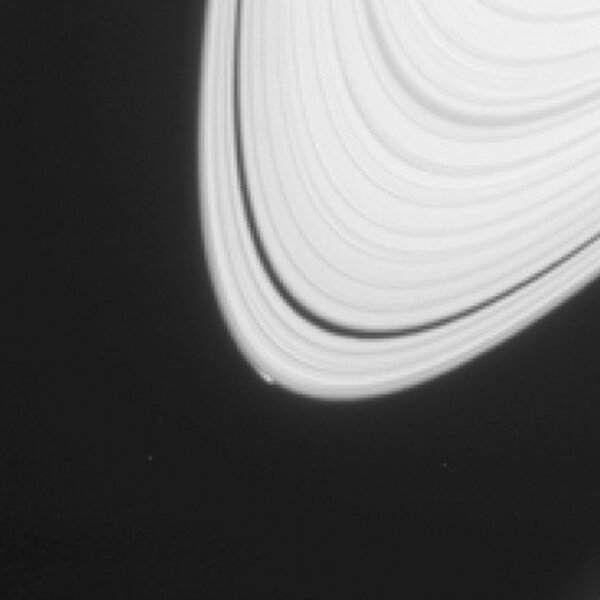Is Saturn giving birth to a new moon?
Loading...
"Peggy" could be the most recent addition to Saturn's family.
On April 15, 2013, images taken by NASA's Cassini spacecraft revealed disturbances at the outer edge of Saturn's A ring. One of these appeared as a "bright, extended feature" at the edge of the ring. It appears to be detached from the ring.
The discovery image, one of a pair of images taken 33 seconds apart, showed an arclike object about 20 percent brighter than its surrounding of immediately adjacent ring materials, 750 miles long and 6 miles wide.
"[T]he feature was apparent in both images thereby ruling out the possibility of it being a cosmic ray artifact," researchers noted in a paper titled "The discovery and dynamical evolution of an object at the outer edge of Saturn’s A ring" published online by the journal Icarus.
"We have not seen anything like this before," Carl Murray of Queen Mary University of London, the report's lead author said in a press release. "We may be looking at the act of birth, where this object is just leaving the rings and heading off to be a moon in its own right." It is also possible that the brightness of the object was due to dust particles left behind after collisions with other objects, he says.
Researchers speculate that Peggy could be the last moon of Saturn because it is likely that Saturn's rings are now all too depleted to give birth to new moons. "The theory holds that Saturn long ago had a much more massive ring system capable of giving birth to larger moons," Dr. Murray said.
Ice is a large component of such satellites. According to a theory about the origin of icy satellites, Saturn's moons begin forming inside the rings, later detaching from the ring system and moving away from the planet.
The size of Saturn's regular moons, that is, satellites that could have originated from the planet's ring system, increases with their distance .
"As the moons formed near the edge, they depleted the rings and evolved, so the ones that formed earliest are the largest and the farthest out," Murray said.
But, in this case further images need to be examined to confirm if the object has actually left or is embedded within the ring system, Murray, who dubbed the discovery "Peggy" after his mother-in-law, told the Monitor.
"Witnessing the possible birth of a tiny moon is an exciting, unexpected event," said Cassini Project Scientist Linda Spilker, of NASA's Jet Propulsion Laboratory in Pasadena, Calif.
Later in 2016 a better view of the region can be obtained when Cassini's orbit moves closer to the outer edge of Saturn's A ring.








